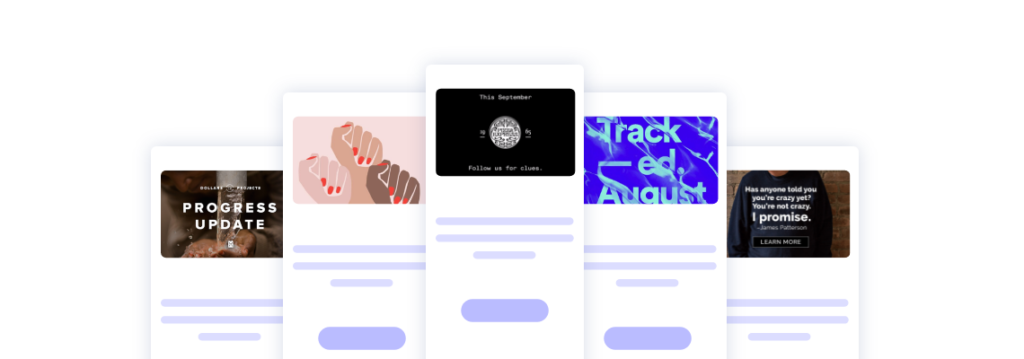If you have decided to market your business with email, it goes without saying that your marketing emails have to stand out. But you probably don’t want to spend ages creating each and every email. And that is where agile email marketing comes into play.
Not only is it important to be efficient with your time, but you must also be adaptable in today’s rapidly-changing business environment. Thanks to social media and the internet, it seems trends can shift overnight. In this post, we’ll take a look at how agile email marketing allows us to achieve these goals - and more.
Table of Contents
- What is agile email marketing?
- Why agile email is important for marketing?
- How to make your email more agile?
- The bottom line about agile email marketing
What is agile email marketing?
If you know anything about project management or software development, you may have heard of agile. Indeed, that is where the term originated. It was first applied to software changes because there can be hundreds of changes during the course of a project. Thus, a team must be able to adapt to changes quickly. To keep up with this fast-paced workflow, many teams also rely on project time tracking software to monitor productivity, allocate resources efficiently, and ensure deadlines are met without unnecessary stress.
Being highly adaptable allows you to make changes more quickly, giving you an edge over other players in the industry. And while email marketing doesn’t involve the same steps as software development, having this philosophy as you approach your email marketing strategy will allow you to move more quickly.
In particular, having a data-driven, customer-focused approach will allow you to react quickly. Even better, you can use templates to drastically cut back on the total time needed to craft your emails.
Collaboration is also an important part of agile email marketing. If you have a fully-staffed marketing team, you likely have several people handling different pieces of the puzzle. Thus, if you aren’t able to effectively coordinate your efforts amongst your team, you will likely run into hangups.
Why agile email is important for marketing?
We have already touched on some of the main reasons agile is important: saving time and being adaptable. However, we should expand on these details a bit. The 2019 State of Email Workflows survey revealed some interesting facts about email marketing. For instance, 53% of respondents said it takes more than two weeks for their team to create a single email. On the other hand, 23% said it takes a few days or less.
Perhaps even more interesting, the survey also showed that the larger the team, the longer the process took. Those with teams of 11 or more said it could take over a month to craft just one email (20% of respondents).
This all highlights the need, not only to make the process more efficient in general, but also the need for better collaboration. Fortunately, agile email management can help in both of these areas. Let’s find out how in the next section.
How to make your email more agile?
We have taken a look at some of the reasons it is so important to make your emails more agile, from saving time to better collaboration. Large corporations can have large teams that make the process drag on for weeks or even a month or more.
At the same time, today’s business world is changing more quickly than ever. If it takes your team a month to create a single email, you may already be too late. Therefore, being able to move quickly is key to a successful email marketing campaign today.
Let’s take a look at some of the ways we can make these processes run more smoothly. Remember, we will use a data-driven, customer-focused approach.
Solidify your strategy
It’s important to solidify your strategy upfront. Trying to “just wing it” almost guarantees you will waste time and be less efficient than you could be. Your strategy should include copy, development, and Ui/UX design. Thus, you must have a strategy that aligns all three of these elements before you start crafting a single email.
And because many marketing teams have so many people involved, everyone must be on the same page. You’ll want to share your strategy with everyone on the team and be sure everyone both agrees with and understands it. You may want to take feedback and questions before moving forward.

Build email templates
One thing that can happen if you don’t solidify your strategy ahead of time is that you may be starting from scratch every time you create an email. But that is bound to take extra time than it would if you have templates you can adapt to a variety of situations.
Plus, the good news is that many marketing automation tools have drag-and-drop editors that make this process easy. You may want to create templates for each of your campaigns as they will likely have different marketing strategies. Email templates are the meat and bones of your agile strategy. Since you already have something built, you won’t have to start from scratch every time.
Streamline workflows
One of the benefits of creating a strategy ahead of time is that everyone on your team knows exactly what is expected of them. Currently, you might have a linear process, where one step is completed after another.
But with agile, you can have several parts of the process in motion at once. For example, design, development, and copywriting can all be addressed at the same time. Even if you’re just getting started, there are steps you can take to improve your processes.
Since you already have templates built, development can take place around your pre-built designs. You might even have generic text in the place where your finished copy will go. And since you already have your design laid out, you can simply plug your copy and any custom images and animations in once they are done. Thus, no one is waiting for anyone else before they can complete their steps.
Analyze the data
Checking your marketing analytics tool is important because it will help you refine your strategy. If you don’t know what’s working, how can you know what needs improvement? Most marketing automation tools have at least some basic analytics built-in. But depending on how in-depth your automation tool is, it can feel a bit overwhelming.
However, checking some of the basics, such as click-throughs, unsubscribes and reading time will help you see what’s working - and what isn’t.
If you are pressed for time, the best thing you can probably do is to write the highest-quality copy you can. People love when you create content that is helpful. The problem? You don’t always know what is going to resonate with your readers. Sometimes, you write something you may think is very valuable, but it might be the case that it falls flat with your audience.
That’s why you need analytics to help see things from the eyes of your readers. You don’t know what you don’t know, as they say.

Testing, testing, testing
Testing goes hand in hand with analytics in terms of helping you refine your strategy. For example, perhaps your analytics revealed one of your campaigns had a lower open rate than expected, or your audience didn’t spend much time reading the emails.
Armed with this knowledge, you may want to do some A/B testing to find what works best. But that isn’t the only type of testing! Indeed, to really solidify your strategy, there are several types of testing you should consider doing:
- Spam testing: If your emails are going straight to spam, your readers may never see them. This can happen frequently with Gmail.
- Loading speed: Are you using a lot of big images and code-heavy elements that take a lot of time to load? If so, that will likely hurt performance and your engagement too.
- Links: Do you have any broken links? That wouldn’t make a good impression.
- Email previews: Do your emails display correctly on desktop, mobile and other platforms? Of course, you want them to look good no matter how your readers are viewing them.
These are just a few examples, but ironing out these details is important. For example, if an email goes to your audience’s spam folders, they will never even see them. So while they seem small at first, you really want to be sure to get these things right.
The bottom line about agile email marketing
Agile email marketing can leave you with more time and more cash to invest. It can take some time up-front to formulate your strategy, but it will pay off in the long run.
Remember, part of the struggle isn’t just being more efficient at what you do, but also coordination between several team members. If you have 10 or more people involved in the process, it’s not uncommon for one person to wait until another person finishes their tasks before they can even start theirs. With agile, several people can be working on their parts simultaneously.
Being able to adapt quickly - indeed, being more agile - can give you an advantage over your competition. Instead of having to wait for weeks until you can press send, you’ll be able to do so in a matter of days.
Beat out the competition and reach your audience sooner. Such is the beauty of agile email marketing technology.







